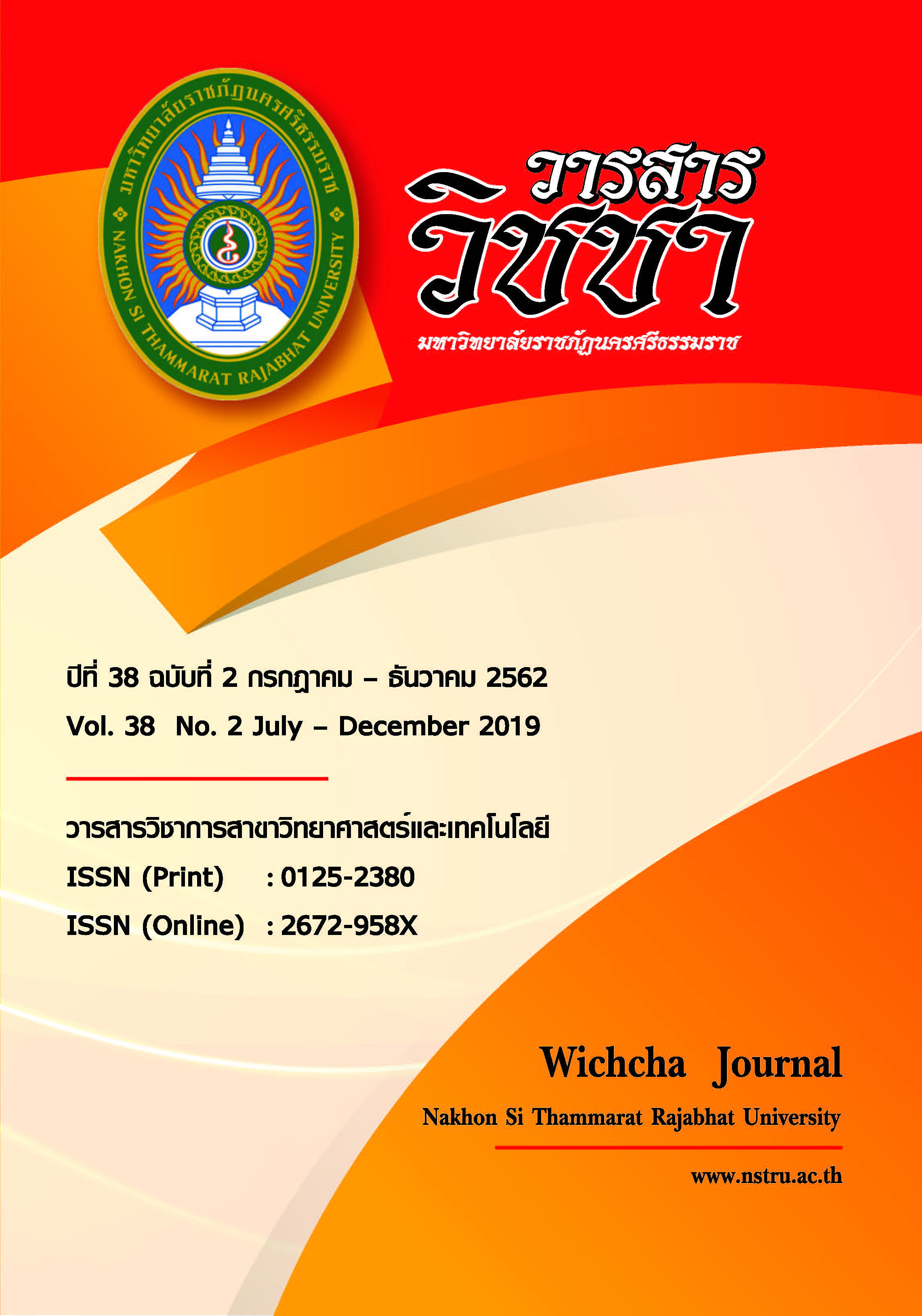Relationship of Total Phenolic Content and Total Flavonoid Content Affecting Antioxidant Activity of Momordica subangulata Bl. and Lepionurus sylvestris Bl. ความสัมพันธ์ของปริมาณฟีนอลิกรวมและปริมาณฟลาโวนอยด์รวม ที่มีต่อฤทธิ์ต้านอนุมูลอิสระของแหมะและหมากหมก
Main Article Content
Abstract
This research is aimed to study the relationship of total phenolic content and total flavonoids content with antioxidant activity of Momordica subangulata Bl. and Lepionurus sylvestris Bl. Leave and fruit of M. subangulata and L. sylvestris were extracted by Soxhlet extractor using ethyl acetate, acetone and ethanol as solvents. The investigation of the total phenolic content was analyzed by Folin-Ciocalteau’s reagent using gallic acid as a standard substance, total flavonoids content using quercetin as a standard substance, and antioxidant activity by 2,2-diphenyl-1-picrylhydrazyl (DPPH) method. The results showed that the acetone extract of leaves of M. subangulata (MSLA) had the most of total phenolic content (150.12±5.41 mgGAE/g extract). The ethanol extract of fruit of L. sylvestris (LSFE) showed the highest of total flavonoids content (0.27±0.00 mgQE/g extract). The antioxidant activity was determined and its result showed that the acetone extract of leaves from M. subangulata (MSLA) showed the strongest antioxidant activity with IC50 of 37.47±8.18 mg/L, followed by the ethyl acetate extract of fruit from L. sylvestris (LSFA, 38.53±1.51 mg/L) and the ethanol extract of fruit from L. sylvestris Bl. (LSFE, 48.17±3.41 mg/L), respectively. The study of relationship between total phenolic content and total flavonoids content with antioxidant activity found that both the total phenolic and total flavonoid contents were negatively correlated with the 50% free radical inhibitory concentration. The total phenolic content had slightly more related than the total flavonoid content with Pearson’s correlation coefficient of -0.779 and -0.755, respectively.
Article Details
เนื้อหาและข้อมูลในบทความที่ลงตีพิมพ์ในวารสารวิชชา มหาวิทยาลัยราชภัฏนครศรีธรรมราช ถือเป็นข้อคิดเห็นและความรับผิดชอบของผู้เขียนบทความโดยตรง ซึ่งกองบรรณาธิการวารสารไม่จำเป็นต้องเห็นด้วยหรือร่วมรับผิดชอบใด ๆ
บทความ ข้อมูล เนื้อหา รูปภาพ ฯลฯ ที่ได้รับการตีพิมพ์ในวารสารวิชชา มหาวิทยาลัยราชภัฏนครศรีธรรมราช ถือเป็นลิขสิทธ์ของวารสารวิชชา มหาวิทยาลัยราชภัฏนครศรีธรรมราช หากบุคคลหรือหน่วยงานใดต้องการนำข้อมูลทั้งหมดหรือส่วนหนึ่งส่วนใดไปเผยแพร่ต่อหรือเพื่อการกระทำการใด ๆ จะต้องได้รับอนุญาตเป็นลายลักษณ์อักษรจากวารสารวิชชา มหาวิทยาลัยราชภัฏนครศรีธรรมราชก่อนเท่านั้น
The content and information in the article published in Wichcha journal Nakhon Si Thammarat Rajabhat University, It is the opinion and responsibility of the author of the article. The editorial journals do not need to agree. Or share any responsibility.
References
มนต์สรวง ยางทอง และนงพร โตวัฒนะ. (2557). ปริมาณฟีนอลิกรวมและฤทธิ์ขจัดอนุมูล DPPH ของสาหร่ายทะเล 6 ชนิด จากชายฝั่งภาคใต้ของประเทศไทย. วารสารวิจัยเทคโนโลยีการประมง, 8(1), 93-104.
ราตรี พระนคร. (2559). ฤทธิ์ต้านอนุมูลอิสระของสารสกัดใบกฤษณา. วารสารพืชศาสตร์สงขลานครินทร์, 3(ฉบับพิเศษ (III)), 21-24.
วรานนท์ ทองอินลา ชลธิชา วรรณวิมลรักษ์ และภารดี ช่วยบำรุง. (2557). ความสัมพันธ์ระหว่างฤทธิ์ต้านอนุมูลอิสระของผลไม้จากการวิเคราะห์ด้วยวิธี DMPD กับปริมาณฟีนอลิก วิตามินซี วิตามินอี และเบต้าแคโรทีน. วารสารวิทยาศาสตร์บูรพา, 19(2), 93-104.
วิยดา กวานเหียน และกิ่งกาญจน์ บรรลือพืช. (2561). ความเป็นพิษต่อเซลล์ ฤทธิ์ต้านการอักเสบและต้านอนุมูลอิสระของ ตำรับยาห้ารากที่สกัดด้วยน้ำ. วารสารวิชชา มหาวิทยาลัยราชภัฏนครศรีธรรมราช, 37(ฉบับพิเศษ), 27-38.
ศรัญญา มณีทอง. (2559). การสกัดและการทดสอบฤทธิ์ต้านอนุมูลอิสระในพืชสมุนไพร 4 ชนิด ด้วยวิธีการทำลายอนุมูลอิสระดีพีพีเอช. สืบค้นเมื่อ 10 กันยายน 2562, จาก: https://dspace.bru.ac.th/ xmlui/handle/123456789/3301.
สุธิรา มณีฉาย และประสบอร รินทอง. (2559). ปริมาณสารประกอบฟีนอลิกและฟลาโวนอยด์ฤทธิ์ต้านอนุมูลอิสระและฤทธิ์ยับยั้งเอนไซม์ไทโรซิเนสของสารสกัดเมทานอลจากดอกถั่วแระและดอกส้มป่อย. วารสารวิทยาศาสตร์มหาวิทยาลัยขอนแก่น, 44(1), 142-152.
อรชร ไอสันเทียะ และกาญจนา วงศ์กระจ่าง. (2558). การศึกษาระบบตัวทำละลายของการสกัดสารประกอบฟีนอลิก สารประกอบฟลาโวนอยด์และฤทธิ์ต้านอนุมูลอิสระที่ดีที่สุดจากดอกดาวเรืองสด. วารสารวิชาการวิทยาศาสตร์และเทคโนโลยี มหาวิทยาลัยราชภัฏนครสวรรค์, 7, 29-40.
อรทัย เนียมสุวรรณ ศรายุทธ ตันเถียร และสุวรรณดี เพ็ชรบุญ. (2557). การสำรวจพืชสมุนไพรที่ใช้บำรุงกำลัง จากอุทยานแห่งชาติเขาพนมเบญจา จังหวัดกระบี่. ไทยเภสัชศาสตร์และวิทยาการสุขภาพ, 9(1), 26-33.
เอนก หาลี และบุณยกฤต รัตนพันธุ์. (2560). การศึกษาประสิทธิภาพในการต้านอนุมูลอิสระจากพืชผักสมุนไพรพื้นบ้าน 15 ชนิด. วารสารวิจัยและพัฒนา มจธ, 40(2), 283-293.
Asha, V.V. (2001). Preliminary studies on the hepatoprotective activity of Mamordica subangulata and Naragamia alata. Indian Journal of Pharmacology, 33, 276-279.
Chaithada, P., Supapan, J., Rodthuk, P. and Chainarong, S. (2018). Total flavonoids, total phenolic content and antioxidant activity from fruits, leaves, twigs and flowers of Mesua ferrea L. Walailak Journal of Science and Technology, 15(4), 295-304.
Nascimentoa, K.S., Sattlera, J.A.G., Macedoa, L.F.L., Gonzálezb, C.V.S., Meloa, I.L.P., Araújoa, E.S., Granatoc, D., Sattlerd, A. and Almeida-Muradiana, L.B. (2018). Phenolic compounds, antioxidant capacity and physicochemical properties of Brazilian Apis mellifera honeys. LWT - Food Science and Technology, 91, 85-94.
Ri, H.I., Kim, C.S., Pak, U.H., Kang, M.S. and Kim, T.M. (2019). Effect of different polarity solvents on total phenols and flavonoids content, and In-vitro antioxidant properties of flowers extract from Aurea Helianthus. Retrieved 24 December 2019, from: https://arxiv.org/abs/1906.12006.
Wu, J.Q., Kosten, T.R. and Zhang, X.Y. (2013). Free radicals, antioxidant defense systems and schizophrenia. Progress in Neuro-Psychopharmacology and Biological Psychiatry, 46, 200-206.


